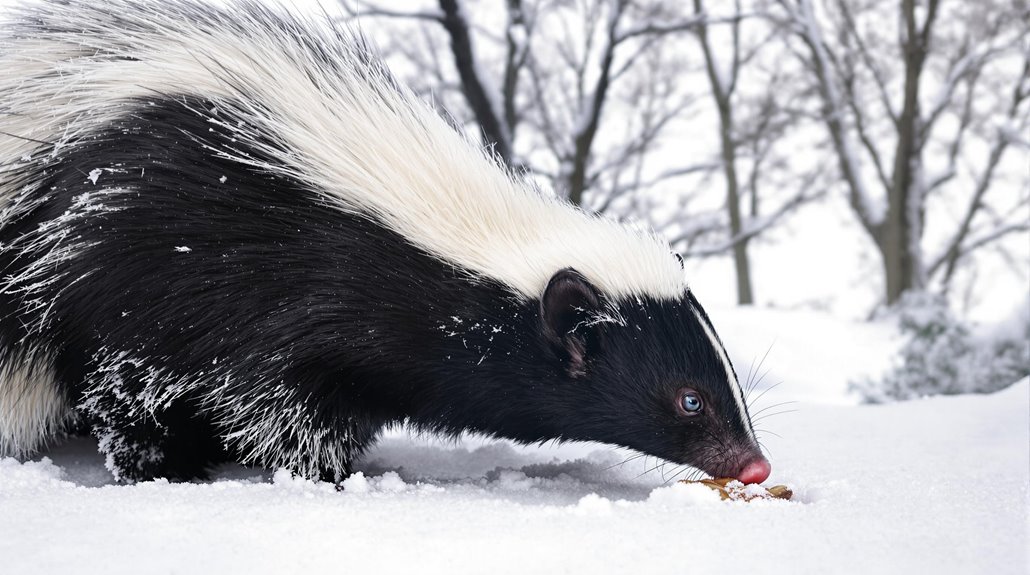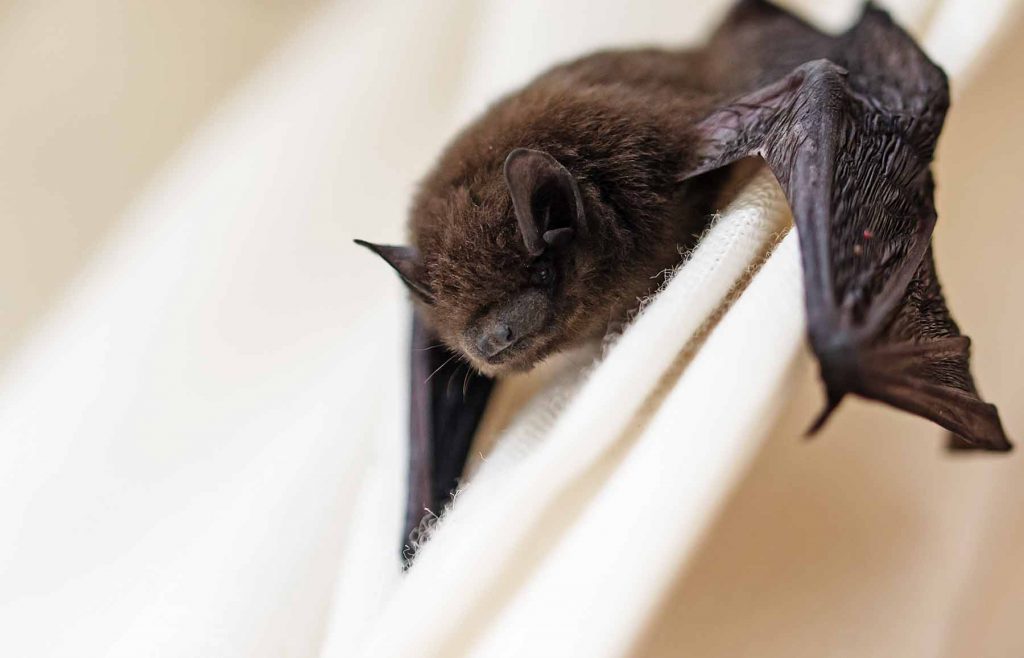In Raleigh, NC, skunks are less active during the winter months due to cold temperatures and limited food availability. They tend to seek shelter and enter a semi-hibernation state, relying on stored fat for survival. Skunks adjust their foraging habits by searching for underground insects, roots, and food scraps in urban areas. Signs of their presence include tracks with five toes and disturbed soil. They use dens for shelter, which can be found in burrows or abandoned buildings. Understanding these behaviors can help with local wildlife management and conservation efforts. More insights on skunk interactions can be found in further details.
Key Article Highlights
- Skunks in Raleigh, NC, exhibit decreased activity during winter due to cold temperatures and reliance on fat reserves.
- They adjust their foraging habits, seeking underground insects, roots, and leftover food from urban gardens.
- Signs of skunk activity include identifiable tracks, overturned soil, and nocturnal sightings, despite less frequent appearances.
- Common winter shelters for skunks include burrows, rock piles, and urban structures like abandoned buildings.
- To minimize skunk encounters, secure trash cans, remove pet food, and clean up fallen fruits and seeds.
Understanding Skunk Behavior
Skunk behavior is influenced by various factors, including temperature and food availability. These animals are primarily nocturnal, often foraging at night to find food. In winter, colder temperatures can affect their activity levels. Skunks may become less active, seeking shelter during extreme cold. During this time, they may also rely on stored fat reserves as a key survival strategy.
Skunk communication plays an essential role in their social interactions. They use various sounds, such as hisses and growls, to express feelings and warn others of danger. Additionally, scent marking is a key method of communication, helping skunks establish territory.
When it comes to skunk reproduction, the breeding season typically occurs in late winter or early spring. Males will actively seek females, using vocalizations and scent to attract mates. After a gestation period of about two months, female skunks give birth to a litter of kits.
Understanding these behaviors helps us appreciate skunks and their role in the ecosystem. Recognizing their communication methods and reproductive patterns allows us to observe them more closely. This knowledge can enhance our connection to these creatures, fostering a sense of freedom and respect for their natural habits. Additionally, the presence of skunks in North Carolina's diverse habitats contributes to the balance of their ecosystems.
Winter Foraging Habits
During winter, skunks adjust their foraging habits to adapt to changing food sources. They often rely on underground insects, roots, and leftover food from other animals. Understanding these changes can help us learn more about their survival strategies in colder months.
Food Sources Available
In winter, food sources for skunks become limited due to the cold and snow-covered ground. However, they are resourceful animals and adapt to find what they need. Urban gardens can be a crucial source of food during this time. Many gardens may still have some leftover vegetables or fruits from the fall harvest. Skunks are known to forage through these gardens, seeking out any edible items that remain.
Seasonal fruits, though scarce in winter, can sometimes be found on trees or bushes that are not fully stripped. Skunks will also dig through the ground to find roots, bulbs, and other plant material that can provide nutrition. They are opportunistic feeders and will take advantage of any food they can find.
In addition to scavenging in urban gardens, skunks may also search for insects and small animals that remain active during the winter months. Their keen sense of smell helps them locate these food sources. By being adaptable, skunks continue to thrive even when their environments change. This resourcefulness is critical for their survival in the colder months.
Foraging Behavior Changes
Foraging behavior changes considerably as winter sets in. Skunks adjust their foraging patterns to cope with the colder weather and reduced food availability. During this time, they often rely on their seasonal adaptations to find food.
In winter, skunks may search for food more actively at night when temperatures are cooler. They tend to dig more frequently, looking for buried insects and roots. This behavior helps them access food sources that may be hidden beneath the frost. Skunks also become opportunistic feeders, scavenging for any available scraps left by humans or other animals.
The shift in foraging patterns is important for their survival. As natural food becomes scarcer, skunks may explore urban areas more often. This change can lead them to dumpsters and garbage cans, where food is more plentiful.
Signs of Skunk Activity
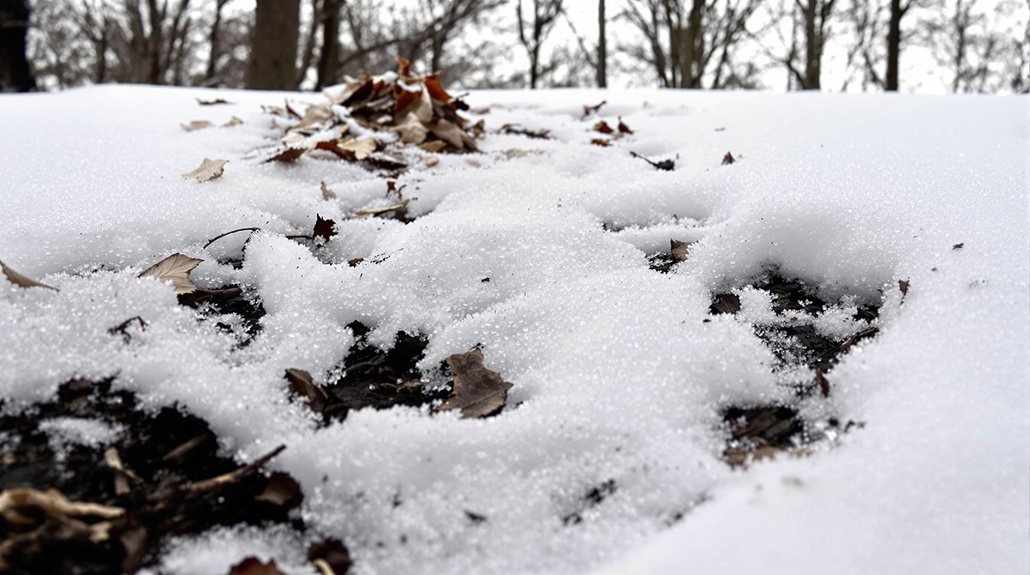
Observing the signs of skunk activity in winter can provide valuable insights into their behavior and presence in your area. During this season, skunks may be less active but can still leave clues of their existence. One of the most noticeable signs is skunk tracks. These tracks are typically small, with five toes and a distinct shape, making them easy to identify in snow or soft ground.
Additionally, skunk sightings can occur even in colder months. While they may not be as frequent, seeing a skunk during winter indicates their presence in your neighborhood. Skunks are generally nocturnal, so late evenings and early mornings are the best times to spot them.
Moreover, you might notice signs of foraging. Skunks often dig in gardens or yards while searching for food. Look for overturned soil or disturbed leaves as indicators of their activity.
Common Skunk Dens
Many skunks create dens in various locations to provide shelter during the winter months. Understanding skunk shelter preferences can help us identify where these animals may be residing, especially in urban settings. Skunks tend to choose dens that offer protection from harsh weather and predators.
Common den locations include:
| Location Type | Description | Examples |
|---|---|---|
| Burrows | Underground tunnels dug by animals | Fields, forests |
| Rock Piles | Natural or man-made rock formations | Gardens, parks |
| Wooded Areas | Dense vegetation and tree cover | Forests, backyards |
| Urban Structures | Spaces under buildings or decks | Residential areas |
| Abandoned Buildings | Unused structures that provide shelter | Warehouses, sheds |
In urban areas, skunk populations thrive by adapting to human environments. They often find denning sites in spaces that are less disturbed. These adaptations allow them to survive and reproduce, even in cities. Knowing where skunks might den can help communities coexist peacefully with these creatures during winter months.
Preventing Skunk Encounters
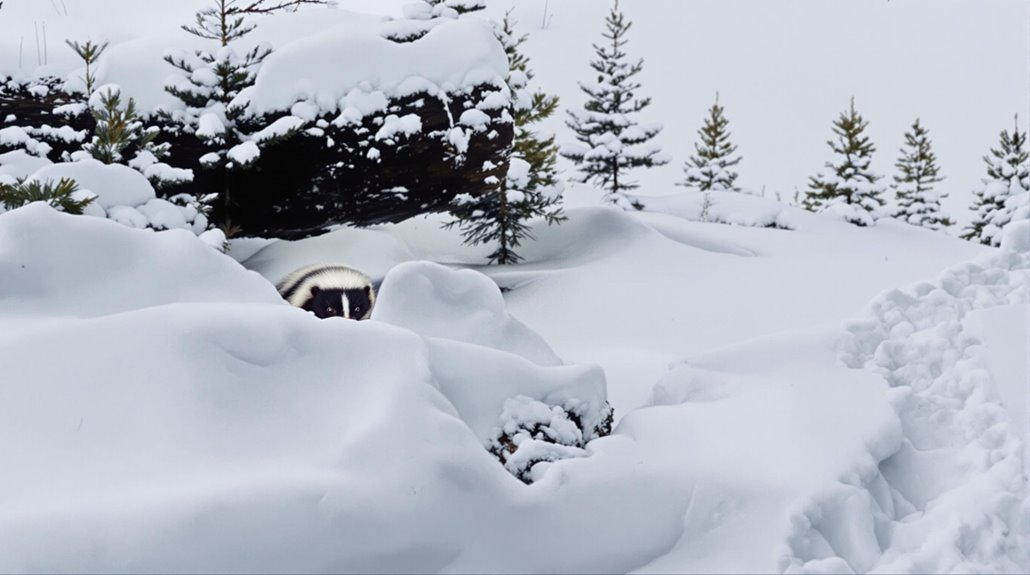
Skunk encounters can be a concern for homeowners, especially during the winter months when these animals seek shelter. To reduce the chances of an encounter, consider some effective skunk prevention tips. First, secure your trash cans with tight-fitting lids. Skunks are attracted to food waste, so keeping trash contained is essential.
Next, make backyard modifications to eliminate hiding spots. Trim overgrown shrubs and remove piles of leaves or wood. These areas can serve as homes for skunks. Additionally, consider installing a fence that is buried a few inches underground. This can help deter skunks from entering your yard.
Another helpful tip is to avoid feeding pets outside. Pet food left unattended can attract skunks and other wildlife. If you have bird feeders, clean up any fallen seeds regularly.
Lastly, be mindful of fallen fruit from trees. Collect and dispose of it promptly to avoid drawing skunks into your yard. By implementing these simple measures, you can enjoy your outdoor space while minimizing the risk of skunk encounters this winter.
Dealing With Skunk Odor
Encountering a skunk can lead to an unpleasant situation, particularly due to the persistent odor that can linger long after the initial spray. It is essential to act quickly for effective skunk scent removal. Here are some methods to help you deal with skunk odor:
- Bathe with a Solution: Use a mixture of hydrogen peroxide, baking soda, and dish soap. This homemade remedy can help neutralize the skunk odor effectively.
- Commercial Products: Look for skunk odor neutralizers in stores. These products are specifically designed for skunk smell and can be very effective.
- Ventilation: Open windows and doors to let fresh air circulate. This can help to dissipate the odor indoors.
- Wash Fabrics: If the smell has clung to clothing or fabrics, wash them using a strong detergent. Adding vinegar to the wash can aid in skunk scent removal.
Safe Removal Techniques
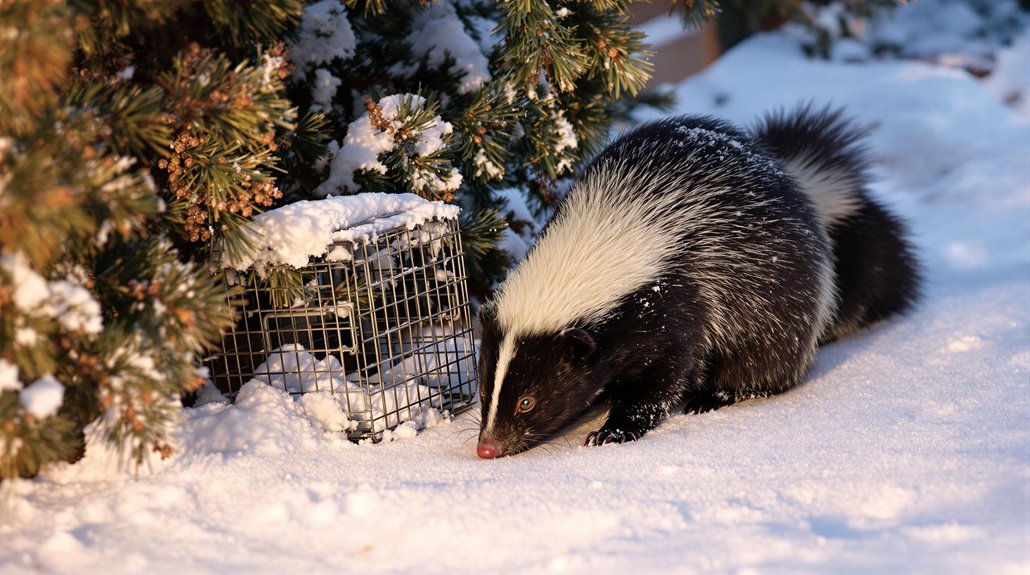
When dealing with wildlife, it is important to prioritize safety, especially during winter when skunks may seek shelter. Skunks can become a nuisance when they invade homes or gardens. To address this issue, safe removal techniques are imperative.
One effective method involves using trapping methods that are both safe and humane. Live traps can be set up near areas where skunks are active. These traps allow for the skunk to be captured without harm. It is essential to check the traps frequently to guarantee that any trapped skunk is not left in distress. Additionally, employing humane opossum control techniques can enhance your overall wildlife management strategy.
Once captured, the skunk can be relocated to a suitable area far from residential zones. This approach not only protects the skunk but also respects its role in the ecosystem. It is significant to follow local laws regarding wildlife relocation to ensure compliance.
Additionally, homeowners can take preventive measures to avoid attracting skunks. Removing food sources, securing trash bins, and closing off potential entry points are effective steps. By employing humane solutions, you can maintain a safe environment for both your family and local wildlife. Furthermore, ensuring that your property is properly proofed can significantly reduce the chances of future skunk invasions.
Local Skunk Conservation Efforts
Local skunk conservation efforts play an important role in protecting these animals. Community awareness programs help educate the public about skunk behavior and their ecological value. Additionally, habitat restoration initiatives and wildlife rehabilitation partnerships work to guarantee skunks have safe environments to thrive.
Community Awareness Programs
Community awareness programs play an essential role in promoting understanding and conservation of skunks during the winter months. These initiatives encourage community engagement and provide valuable information to residents. By educating the public, we can foster a respectful coexistence with these often-misunderstood animals.
Here are some key components of effective community awareness programs:
- Educational Workshops: These sessions allow experts to share knowledge about skunk behavior, habitat, and the importance of their role in the ecosystem.
- Community Events: Local gatherings can bring families together to learn about skunks through fun activities, games, and discussions.
- Informational Materials: Flyers, brochures, and social media posts can help spread awareness about skunk conservation and how to safely interact with them.
- Volunteer Opportunities: Engaging residents in hands-on activities, such as habitat cleanup or wildlife monitoring, can deepen their connection to skunks and their environment.
Through these programs, we can empower individuals to take action. This not only helps skunks but also enriches our community as a whole. Together, we can create a favorable environment for skunks during the winter season.
Habitat Restoration Initiatives
Though often overlooked, habitat restoration initiatives are fundamental for the conservation of skunks in winter. These efforts focus on habitat enhancement to support local skunk populations. In Raleigh, NC, various organizations work to improve natural environments. This includes planting native vegetation and removing invasive species. Such actions create a more suitable home for skunks.
Healthy habitats promote ecological balance. Skunks play an essential role in their ecosystems. They help control insect and rodent populations, which can otherwise grow unchecked. By restoring habitats, we guarantee skunks can thrive. This benefits not only the skunks but also the wider environment.
Community involvement is imperative in these initiatives. Residents can participate in local clean-up events or plant native trees and shrubs. These small actions contribute to larger goals of habitat restoration. Educating the public about the importance of skunks and their habitats fosters a sense of responsibility.
Wildlife Rehabilitation Partnerships
Habitat restoration efforts often go hand in hand with wildlife rehabilitation partnerships aimed at skunk conservation. These collaborations involve various groups working together to protect skunks and their habitats. Local outreach initiatives help raise awareness about skunk conservation and the significance of preserving their environment.
Key components of these partnerships include:
- Rehabilitation centers that provide care for injured or orphaned skunks.
- Wildlife volunteers who assist in caring for animals and educating the public.
- Community partnerships that connect local organizations and residents to support skunk conservation.
- Educational workshops that teach the community about species protection and habitat preservation.
Rescue organizations play a crucial role in these efforts by responding to emergencies and providing guidance on skunk care. These partnerships not only focus on immediate rescue but also promote long-term conservation strategies. By fostering collaboration among local groups, we can guarantee that skunks thrive in their natural habitat. Together, we can build a healthier ecosystem and secure a future for these important creatures. Through active participation, we create a sense of freedom for skunks to live and flourish in Raleigh, NC.
Frequently Asked Questions
Do Skunks Hibernate During the Winter in Raleigh, NC?
Skunks do not truly hibernate; instead, their winter habits involve reduced activity. During colder months, skunk behavior typically includes seeking shelter and conserving energy, resulting in less frequent foraging and a more dormant lifestyle.
What Time of Day Are Skunks Most Active in Winter?
Skunks exhibit nocturnal habits, meaning they are most active during the night. Their behavior typically involves foraging and searching for food, making nighttime the ideal period to observe these creatures in their natural environment.
Can Skunks Climb Trees or Fences?
Skunks exhibit limited climbing abilities. While they can ascend small fences or low branches, their skunk behavior primarily involves ground activity. They prefer to stay on the ground where they can easily find food and shelter.
Are Skunks Solitary or Social Animals in Winter?
"Birds of a feather flock together." However, skunks are primarily solitary animals, exhibiting winter adaptations that enable them to survive alone. Their skunk behavior includes seeking shelter and conserving energy during the colder months.
What Predators Threaten Skunks in the Raleigh Area?
Skunk predators in urban wildlife areas include coyotes, foxes, and domestic dogs. These animals pose a threat to skunks, particularly in regions where habitat overlap occurs, increasing the likelihood of encounters between species.
